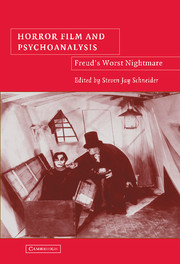Book contents
- Frontmatter
- Contents
- Acknowledgments
- Foreword: “What Lies Beneath?”
- Introduction: “Psychoanalysis in/and/of the Horror Film”
- PART ONE THE QUESTION OF HORROR-PLEASURE
- PART TWO THEORIZING THE UNCANNY
- PART THREE REPRESENTING PSYCHOANALYSIS
- 9 What Does Dr. Judd Want? Transformation, Transference, and Divided Selves in Cat People
- 10 “Ultimate Formlessness”: Cinema, Horror, and the Limits of Meaning
- 11 Freud's Worst Nightmare: Dining with Dr. Hannibal Lecter
- PART FOUR NEW DIRECTIONS
- Afterword: Psychoanalysis and the Horror Film
- About the Contributors
- Bibliography
- Index
9 - What Does Dr. Judd Want? Transformation, Transference, and Divided Selves in Cat People
Published online by Cambridge University Press: 14 July 2009
- Frontmatter
- Contents
- Acknowledgments
- Foreword: “What Lies Beneath?”
- Introduction: “Psychoanalysis in/and/of the Horror Film”
- PART ONE THE QUESTION OF HORROR-PLEASURE
- PART TWO THEORIZING THE UNCANNY
- PART THREE REPRESENTING PSYCHOANALYSIS
- 9 What Does Dr. Judd Want? Transformation, Transference, and Divided Selves in Cat People
- 10 “Ultimate Formlessness”: Cinema, Horror, and the Limits of Meaning
- 11 Freud's Worst Nightmare: Dining with Dr. Hannibal Lecter
- PART FOUR NEW DIRECTIONS
- Afterword: Psychoanalysis and the Horror Film
- About the Contributors
- Bibliography
- Index
Summary
Why should we take psychoanalysis seriously in thinking about Hollywood movies? Let me propose the simplest answer: because Hollywood took psychoanalysis seriously. In claiming this, I don't want to overlook doubts about the depth of psychoanalytic understanding in Hollywood films, since such doubts are in fact commonplace. Still, as Nathan G. Hale has noted in The Rise and Crisis of Psychoanalysis in the United States, “The number of Hollywood movie stars, directors, and producers who were ‘in analysis’ was legion” (289). Taking this fact into account should lead us at the least to posit that psychoanalytic theory is not necessarily external, something that we as critics and scholars might wish to impose on texts, but, rather, that it is possibly immanent in the texts themselves. Furthermore, it may be present in varying degrees with varying degrees of sophistication and variously articulated.
If we question the level of sophistication in films dealing explicitly or implicitly with psychiatry of any kind, we might in part be questioning the use of generic conventions. The issue here should be how the formal constraints of Hollywood filmmaking – demands of characterization and dramatic structure – in effect become filters through which psychoanalytic thought might be expressed. In trying to determine how conventions might shape articulation of thought, I want to focus on horror films in this essay for two reasons: the conventions of the horror film are much more formulaic than those of realistic drama; furthermore, the fantastic material of the horror film seems particularly suited to psychoanalytic interpretation.
- Type
- Chapter
- Information
- Horror Film and PsychoanalysisFreud's Worst Nightmare, pp. 159 - 176Publisher: Cambridge University PressPrint publication year: 2004



